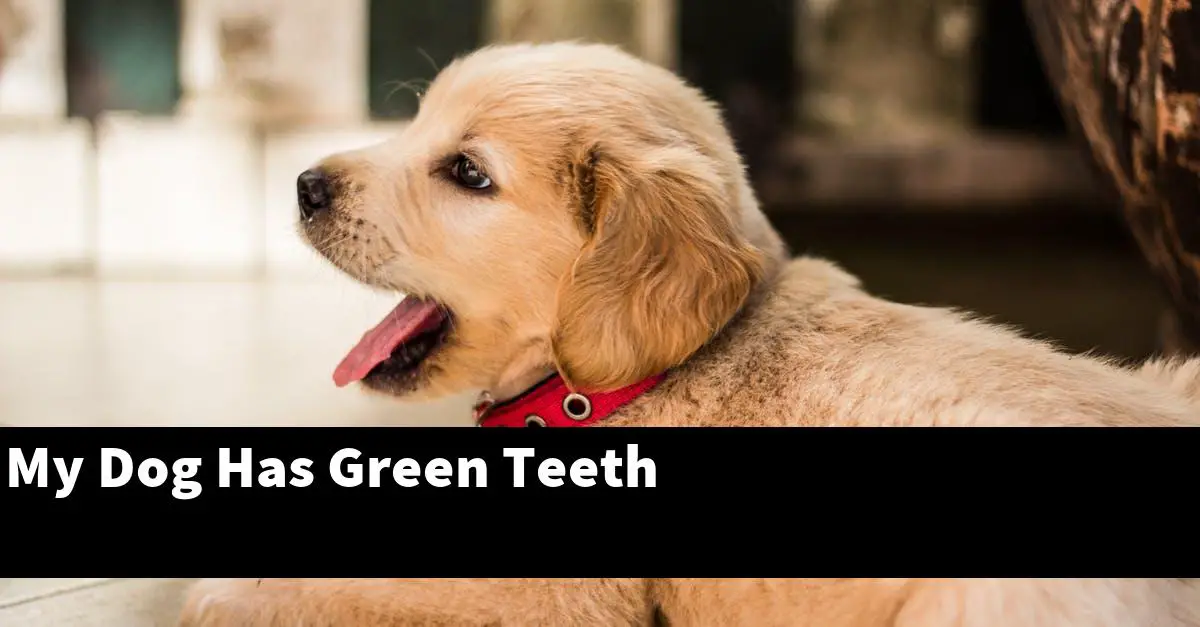Why does my dog have green teeth?
This is not a medical condition, but rather a common occurrence in dogs. The green color is caused by the accumulation of plaque and tartar on the teeth.
The article will be discussing why the dog’s teeth are green and how to fix the problem.
Table of Contents
What could be causing my dog’s green teeth?
Green teeth can be caused by a number of things in dogs. The most common cause is plaque and tartar buildup on the teeth. This can be caused by a number of things, including not brushing the teeth regularly, not getting enough dental cleanings, and eating a diet high in sugar.
Plaque and tartar can also cause gum disease, which can lead to green teeth. Other causes of green teeth include infections, trauma, and certain medications. If you are concerned about your dog’s green teeth, it is best to consult with a veterinarian.
How can I get rid of the green tint on my dog’s teeth?
If you’re concerned about the green tint on your dog’s teeth, there are a few things you can do to help. First, you can try brushing your dog’s teeth with a toothbrush and toothpaste made specifically for dogs. You can also give your dog dental chew toys and treats to help remove plaque and tartar buildup. Finally, you can take your dog to the vet for professional teeth cleaning.
Is it harmful for my dog to have green teeth?
Many people are concerned about their dog’s teeth, especially if they notice that their dog’s teeth are turning green. While it may be alarming to see green teeth in your dog, it is important to remember that this is not necessarily a sign of poor dental health.
In fact, green teeth in dogs can often be a sign of good oral health, as it indicates that the dog is getting enough chlorophyll from their diet.
While green teeth are not necessarily a cause for concern, it is important to keep an eye on your dog’s overall dental health. Be sure to brush your dog’s teeth regularly and take them to the vet for regular check-ups. If you notice any other changes in your dog’s dental health, such as red gums or excessive tartar buildup, be sure to speak to your vet about these concerns.
What can I do to prevent my dog’s teeth from turning green?
To prevent your dog’s teeth from turning green, you should brush their teeth regularly with dog-specific toothpaste. You can also give them dental chews and toys to help clean their teeth. It’s important to take them to the vet for regular checkups and to get their teeth cleaned if necessary.
How do you get green plaque off a dog’s teeth?
It’s important to keep your dog’s teeth clean and free of plaque to prevent gum disease and other oral health problems. You can remove plaque from your dog’s teeth at home by brushing them regularly with dog toothpaste and a soft-bristled toothbrush.
You can also give your dog dental chew treats and bones to help reduce plaque buildup. If plaque is not removed, it can harden and turn into tartar, which can only be removed by a veterinarian.
How do I know if my dog’s tooth is infected?
If you suspect that your dog’s tooth is infected, it is important to take them to the vet as soon as possible. There are a few signs that you can look for that may indicate an infection, including:
- Bad Breath – If your dog’s breath suddenly becomes much worse than usual, it could be a sign of an infection.
- Swelling – If you notice that your dog’s gums are swollen or the area around their tooth is tender to the touch, it could be a sign of an infection.
- Bleeding – If you notice that your dog is bleeding from their gums or mouth, it could be a sign of an infection.
- Loss of Appetite – If your dog suddenly stops eating or seems to have lost their appetite, it could be a sign of an infection.
- If you notice any of these signs, it is important to take your dog to the vet as soon as possible so that they can be treated.
What do dogs’ rotten teeth look like?
Dogs have 42 teeth in total, just like humans. However, their teeth are much different in both structure and function. For example, dogs have canines, or “fangs,” which are much longer and sharper than human canines. Additionally, dogs’ teeth are meant primarily for gripping and tearing food, rather than for chewing.
Because of their different teeth structure and functions, dogs are more susceptible to tooth and gum problems than humans. One of the most common problems is tartar buildup. Tartar is a yellowish substance that forms on the teeth when plaque, or bacteria, is not removed properly.
If tartar is not removed, it can lead to gingivitis or inflammation of the gums. Gingivitis is a reversible condition, but if it is left untreated, it can progress to periodontal disease. Periodontal disease is a serious bacterial infection that affects the gums, bones, and connective tissues that support the teeth. Periodontal disease is the leading cause of tooth loss in dogs.
Another common dental problem in dogs is tooth resorption. Tooth resorption is a condition in which the tooth structure is gradually destroyed and replaced by abnormal tissue. Tooth resorption is painful and can eventually lead to tooth loss.
If you notice any changes in your dog’s teeth or gums, it is important to take them to the vet for an evaluation. Your vet will be able to determine the cause of the problem and recommend the best course of treatment.
How do you get rid of bacteria on a dog’s teeth?
Bacteria are present in the mouth in great numbers and are responsible for dental plaque formation. Plaque is a soft, sticky film that constantly forms on teeth. Plaque is made up of food debris, saliva, and millions of bacteria. If plaque is not removed, it can harden and turn into tartar (calculus). Tartar is a hard deposit that can only be removed by a professional cleaning.
Brushing your dog’s teeth regularly is the best way to remove plaque and bacteria and prevent tartar buildup. Use a soft-bristled toothbrush and toothpaste made specifically for dogs. Be sure to brush all surfaces of the teeth, including the back teeth. You may need to lift the lips to get a good view of all the teeth.
In addition to brushing, give your dog dental chews or treats that help reduce plaque and tartar. These products will not remove plaque and tartar, but they can help reduce their buildup. Look for products that are ADA (American Dental Association) approved.
If plaque and tartar are not removed, they can lead to gingivitis, an inflammation of the gums. Gingivitis is characterized by red, swollen, and bleeding gums. If gingivitis is not treated, it can progress to periodontitis, a more serious inflammation of the tissues that support the teeth. Periodontitis can lead to tooth loss.
Conclusion
I was recently at the dog park with my dog, Max. I noticed that his teeth were looking a bit green. I asked the other dog owners if they had noticed anything similar with their dogs, and they all said no.
I did some research and found out that green teeth in dogs is actually pretty common. It’s caused by a build-up of plaque and tartar on the teeth. I was relieved to find out that it’s nothing serious and that there are ways to prevent it.
I’ve started brushing Max’s teeth every day and I’m also giving him dental treats. His teeth are looking much better now.
If you’re concerned about your dog’s green teeth, don’t worry! It’s common and there are things you can do to help. Just be sure to brush their teeth regularly and give them dental treats to help keep their teeth healthy and clean.


